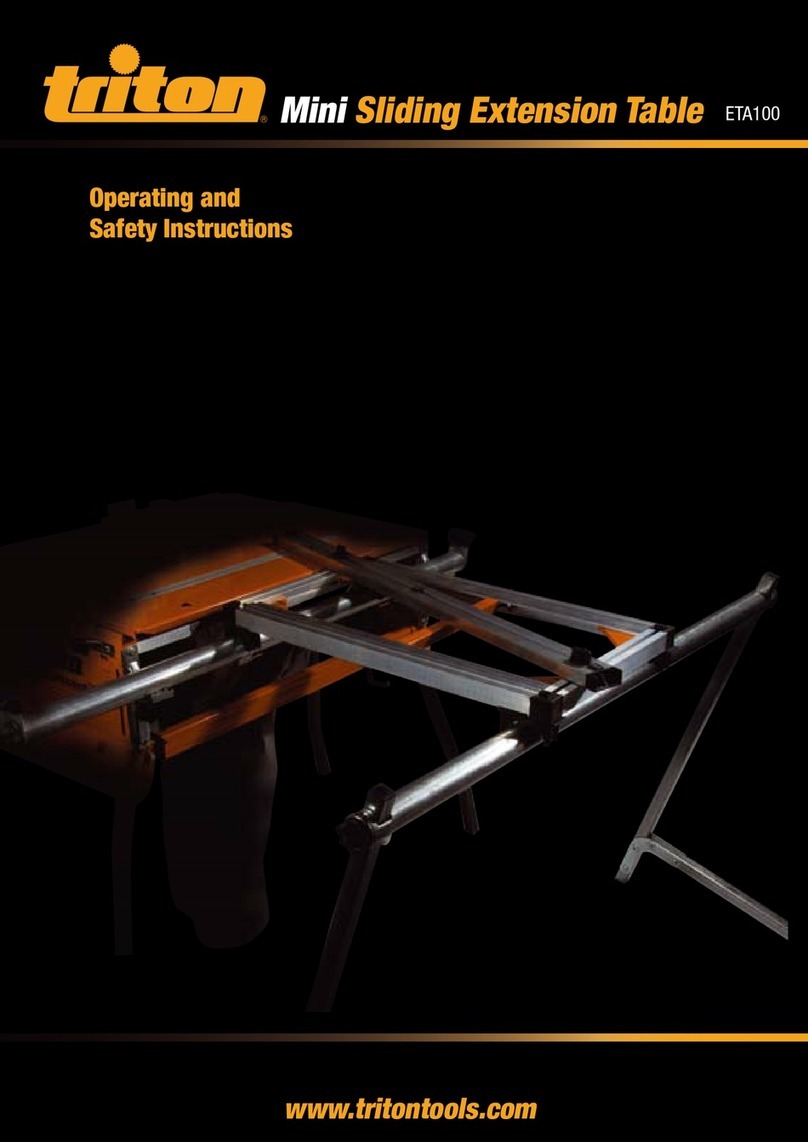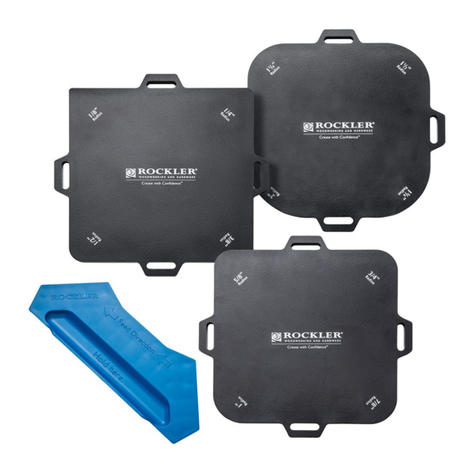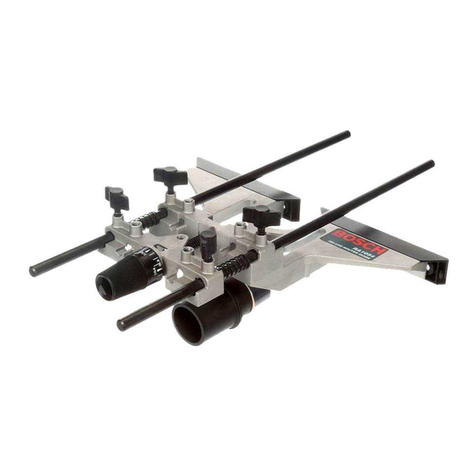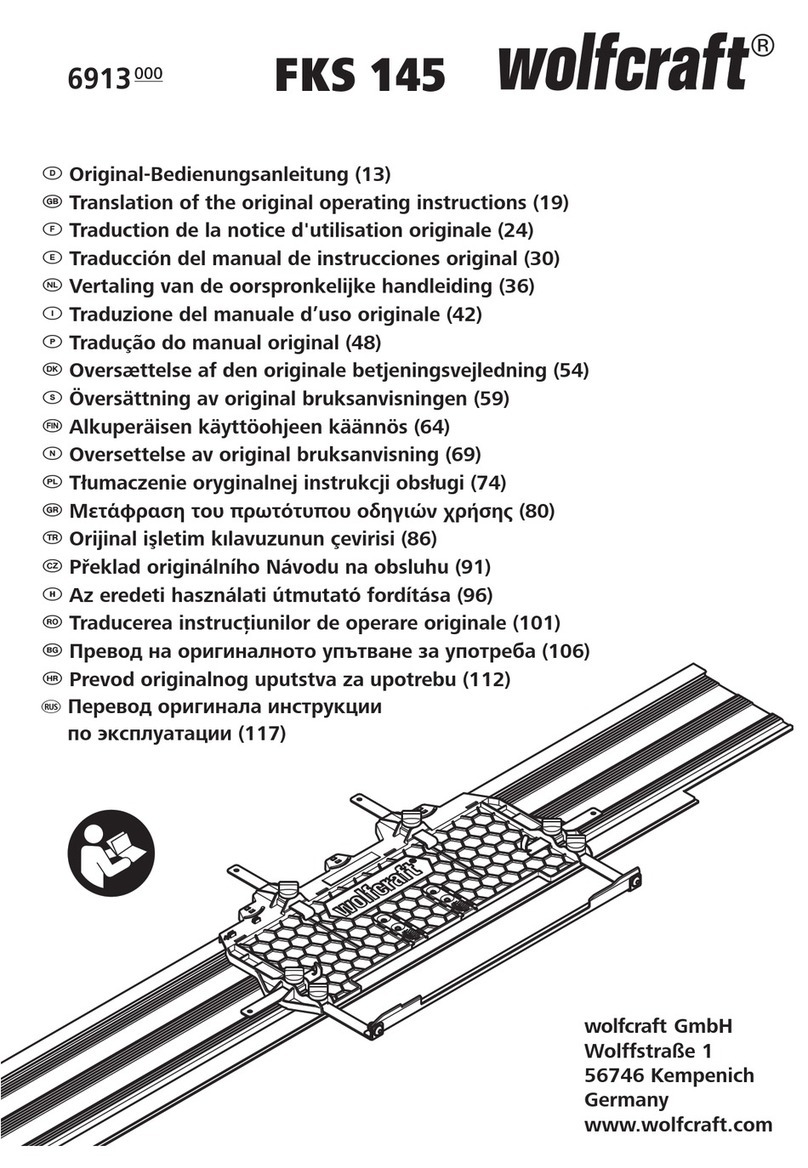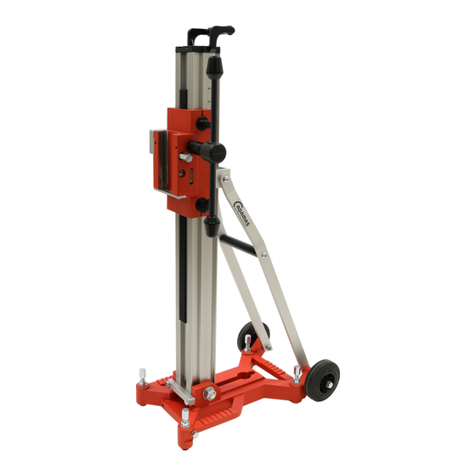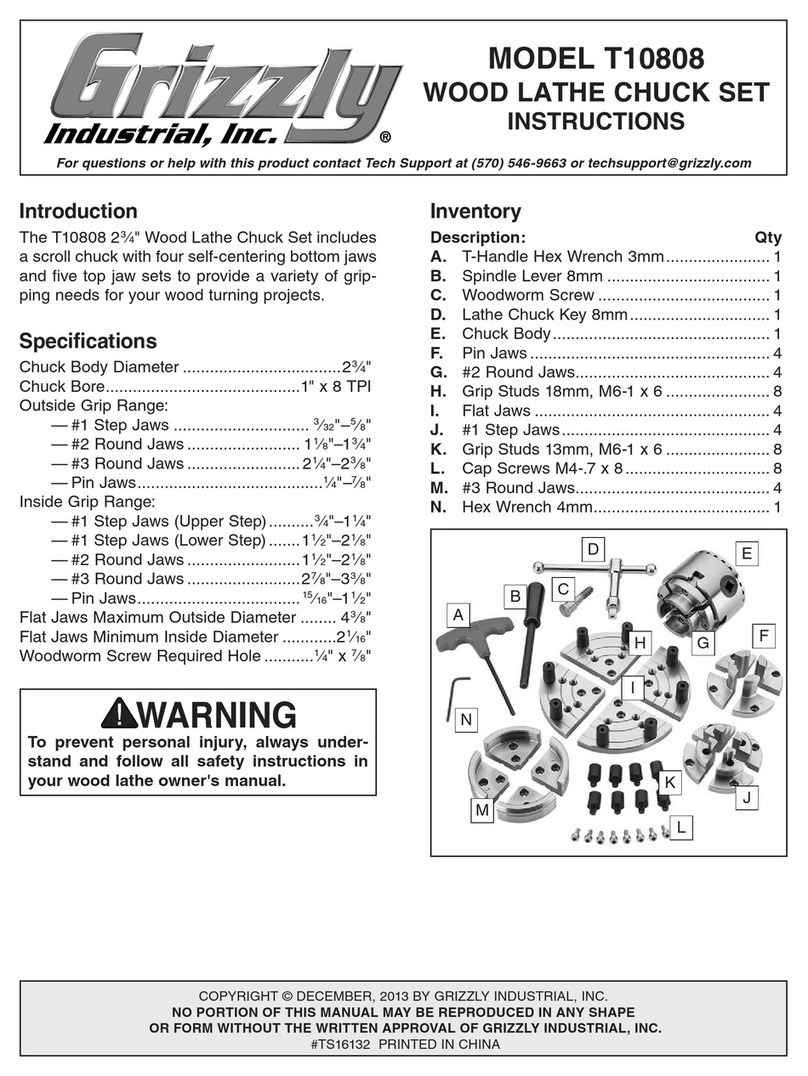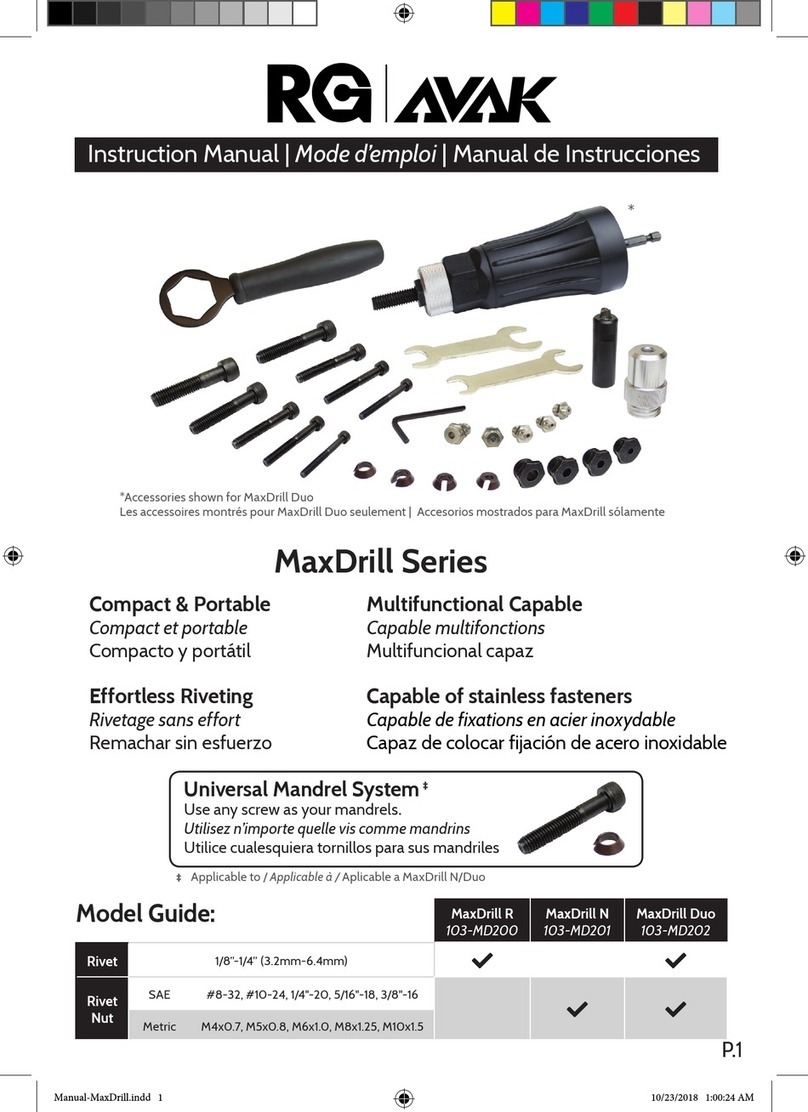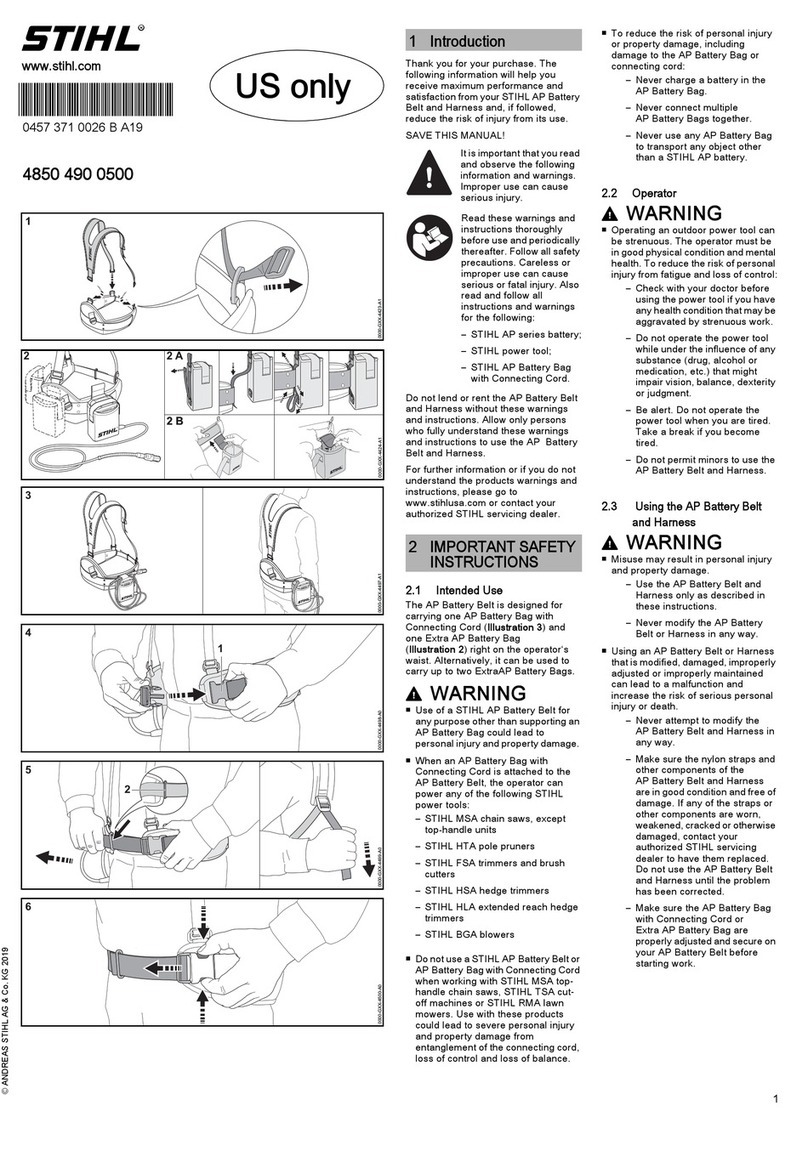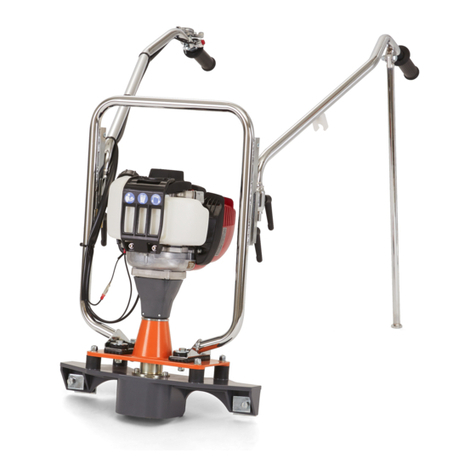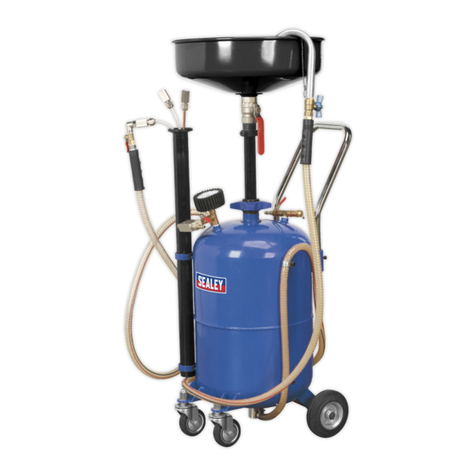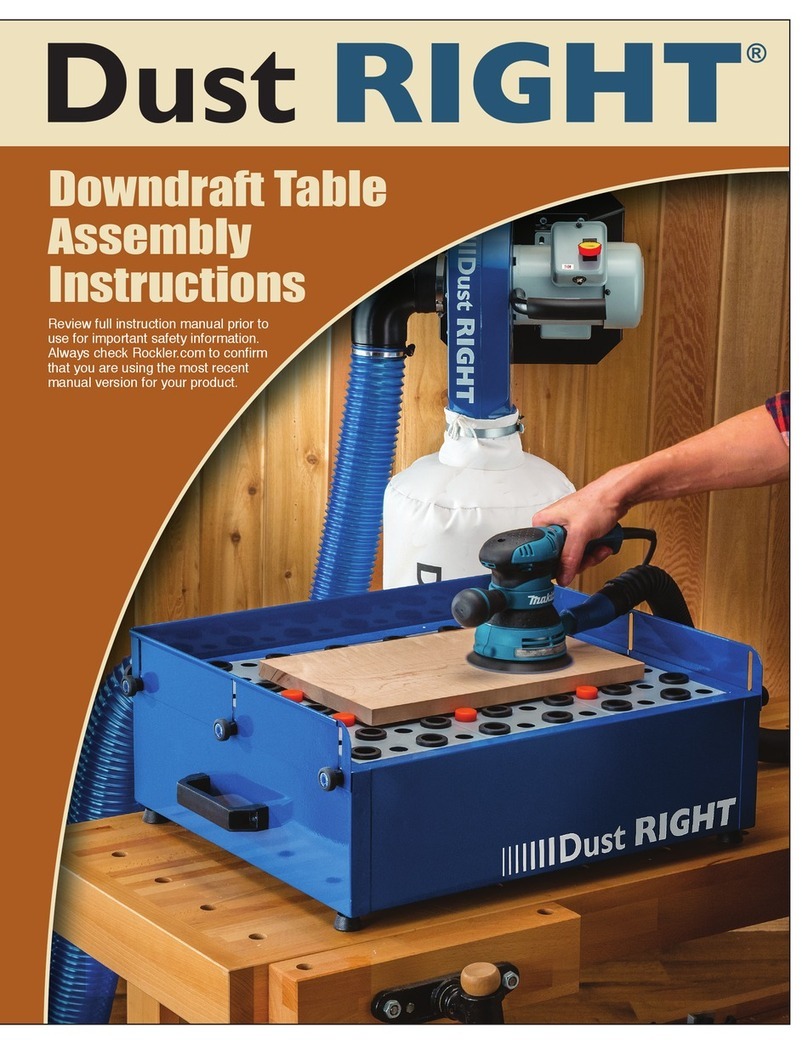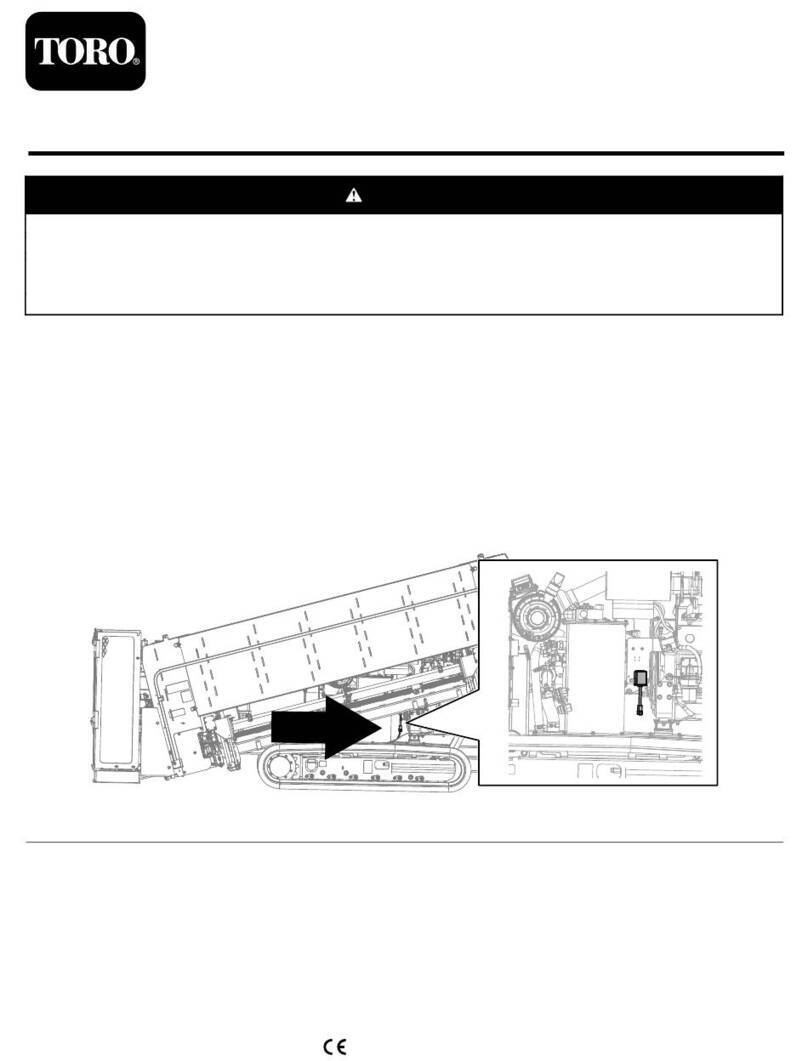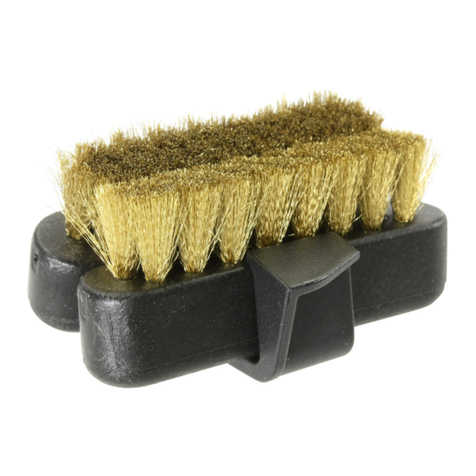Triton AJA150 Quick guide

Overhead Mounting Kit
www.tritontools.com
AJA 150
Operating and
Safety Instruction
Bedienings- en veiligheids-
voorschriften
Instructions D’utilisation &
Consignes De Sécurité
Gebrauchs- und
Sicherheitsanweisung
Istruzioni Per L'uso E La
Sicurezza
Instrucciones De Funcionamiento
Y Seguridad

2 3
GB GB
Contents / Symbols / Guarantee Parts List
PARTS LIST
A. Mounting Plate (1) B. Alignment Disc (1) C. Adaptor Ring (1)
E. Router Locators (4) F. Coach Bolts (4) G. Spring Washers (8) H. Hex Nuts (4)
I. Top Clamps (4) J. Wing Nuts (4) K. Washers (4)
D. Adaptor Ring (1)
CONTENTS
Thank you for purchasing this Triton tool. These instructions contain information necessary
for safe and effective operation of this product.
Please read this manual to make sure you get the full benefit of this unique Triton product.
Keep this manual close to hand and ensure all users of this tool have read and fully understand the instructions.
Symbols 2
Guarantee 2
Parts List 3
Safety 4
Setting Up 5
SYMBOLS
Always wear ear, eye and respiratory
protection.
WARNING. To reduce the
risk of injury, user must read instruction
manual.
Instruction warning.
To register your guarantee visit our web site at
www.tritontools.com* and enter your details.
Your details will be included on our mailing list
(unless indicated otherwise) for information on
future releases. Details provided will not be made
available to any third party.
PURCHASE RECORD
Date of Purchase: ___ / ___ / ____
Model: AJA150
Serial Number: __________________
Retain your receipt as proof of purchase
Hand-Held Operation
Triton Precision Power Tools guarantees
to the purchaser of this product that if
any part proves to be defective due to
faulty materials or workmanship within 12
MONTHS from the date of original purchase,
Triton will repair, or at its discretion replace,
the faulty part free of charge.
This guarantee does not apply to
commercial use nor does it extend to
normal wear and tear or damage as a result
of accident, abuse or misuse.
* Register online within 30 days.
Terms & conditions apply.
This does not affect your statutory rights
GUARANTEE

4 5
GB GB
SAFETY INSTRUCTIONS
Safety Instructions Safety Instructions / Setting Up
WARNING. Read all safety warnings
and all instructions. Failure to follow the
warnings and instructions my result in
electric shock, fire and/or serious injury.
Save these instructions for future use.
1. WORK AREA SAFETY
a. Keep work area clean and well lit. Cluttered
and dark areas invite accidents.
b. Do not operate power tools in explosive
atmospheres, such as in the presence of
flammable liquids, gases or dust. Power tools
create sparks which may ignite the dust or
fumes.
c. Keep children and bystanders away while
operating a power tool. Distractions can cause
loss of control.
2. ELECTRICAL SAFETY
WARNING. The rating plate on your tool may
show symbols. These represent important
information about the product or instructions
on its use. Ensure your mains supply voltage is
the same as your tool rating plate voltage.
a. Power tool plugs must match the outlet.
Never modify the plug in any way. Do not use
adapter plugs with earthed (grounded) power
tools. Unmodified plugs and matching outlets
will reduce the risk of electric shock.
b. Ensure that extension cables used with this
planer have the right ampere rating for your
planer and are in safe electrical condition.
Completely unwind cable drum extensions to
avoid potential overheating.
c. Avoid body contact with earthed or grounded
surfaces such as pipes, radiators, ranges
and refrigerators. There is an increased risk
of electric shock if your body is earthed or
grounded.
d. Do not abuse the power lead. Never use the
power lead for carrying, pulling or unplugging
the power tool. Keep the power lead away
from heat, oil, sharp edges or moving parts.
Damaged or entangled leads increase the risk
of electric shock.
e. Do not expose power tools to rain or wet
conditions. Water entering a power tool
will increase the risk of electric shock. e. If
operating a power tool in a damp location is
unavoidable, use an extension lead suitable
for outdoor use and a residual current device
(RCD) protected supply to reduce the risk of
electric shock.
3. PERSONAL SAFETY
a. Do not use power tools while you are tired
or under the influence of drugs, alcohol or
medication. A moment of inattention while
operating power tools may result in serious
personal injury.
b. Always use safety equipment: wearing eye
protection, hearing protection, dust mask,
gloves, non-slip safety shoes and hard hat,
used in appropriate conditions will reduce
personal injuries.
c. Wear suitable clothing and footwear. Do not
wear loose clothing, neckties, jewellery, or
other items which may become caught. Wear
non-slip footwear or where appropriate,
footwear with protective toe caps. Long hair
should be covered or tied back.
d. Remove any adjusting key or wrench before
turning the power tool on. A wrench or a key
left attached to a rotating part of the power
tool may result in personal injury.
e. Avoid accidental starting. Ensure the switch
is in the ‘Off’ position before plugging in.
Carrying power tools with your finger on the
switch or connecting to power with the switch
on the ‘On’ position invites accidents.
f. If devices are provided for the collection of
dust particles, ensure these are connected
and correctly used. Use of these devices can
reduce dust related hazards.
g. Keep hands away from rotating parts.
h. After long working periods, external metal
parts and accessories may be hot.
i. Do not over-reach. Keep secure footing and
balance at all times. This enables better
control of the power tool in unexpected
situations.
4. POWER TOOL USE AND CARE
WARNING. Before connecting a tool to a
power source (mains socket power point
receptacle, outlet, etc.) be sure that the
voltage supply is the same as that specified
on the nameplate of the tool. A power source
with a voltage greater than that specified for
the tool can result in serious injury to the user,
as well as damage to the tool. If in doubt, do
not plug in the tool. Using a power source with
a voltage less than the nameplate rating is
harmful to the motor.
a. Using the correct power tool for your
application will be safer and produce better
results at the rate for which it was designed.
b. Do not use the power tool if the ‘On/Off’
switch is not working correctly. Power tools
that cannot be controlled by the switch are
dangerous and must be repaired prior to use.
c. Disconnect the plug from the power source
before making any adjustments, changing
accessories or storing power tools. Such
preventive safety measures reduce the risk of
starting the power tool accidentally.
d. Do not force the tool, or use it for a purpose
for which it was not designed, let it work at
a reasonable speed. Overloading will occur if
too much pressure is applied, and the motor
slows, resulting in a poor quality result and
possible damage to the motor.
e. Power tools are dangerous in the hands of
untrained users. Store power tools out of
reach of children, and do not allow persons
who are unfamiliar with the product or these
instructions to operate the power tool.
f. Maintain power tools. Check for misalignment,
binding or breakage of moving parts, and any
other condition that may affect the operation
of the power tool. If damaged, have the power
tool repaired before use. Accidents are caused
by poorly maintained power tools.
g. Keep cutting tools sharp and clean. Correctly
maintained cutting tools with sharp cutting
edges are less likely to bind and are easier to
control.
h. Use the power tool, accessories and tool
bits in accordance with these instructions
and in the manner intended for the particular
type of power tool, taking into account the
working conditions and the work to be carried
out. Failure to use the tool for its intended
purposes could result in a hazardous situation
and may invalidate the warranty.
5. SERVICE
a. Have your power tool serviced by a qualified
repair technician, using only identical
replacement parts. This will ensure that the
safety of the power tool is maintained.
Fitting your router
The Alignment Disc (B) provides easy and
accurate positioning of the router on the
Mounting Plate (A).
First fit a straight cutter to your router. The
alignment disc fits onto a 1⁄2" shank cutter, but
if you are fitting a 1⁄4" or a 5⁄16" shank cutter, use
the appropriate Adaptor Ring (C or D), located in
the sides of the disc. The adaptor ring fits into
the centre of the alignment disc. It should be
fitted to the cutter shank before fitting the cutter
to the router.
Fit the mounting plate into the bearing channels
of the workcentre.
Set the router height so that the cutter shank
protrudes through the hole in the mounting plate.
Push the alignment disc onto the shank of the
cutter and lock it into the centred position.
Manoeuvre the router until you are able to clip
the disc into the hole in the mounting plate. The
router is now exactly centred over the hole in the
plate.
Fit the four Router Locators (E) to the longer
slots in the plate, using the four Coach Bolts (F),
Spring Washers (G) and Hex Nuts (H), as shown
in Fig.1. Note that the lower lip of each locator
should fit hard up against the side of the router
base. Do not completely tighten the hex nuts yet.
If the router has a round base you should now
be able to rotate the router until there are four
clear positions on the top edge of the base for
fitting the top clamps. The router handles may
overhand the edges of the plate, try to keep this
overhang to a minimum.
SETTING UP
Fig.1.

6 7
GB GB
Fitting your jigsaw
To fit your jigsaw to the mounting plate use the
Coach Bolts (F), and only use the top Clamps (I),
as shown in Fig.4. Use the Washers (K), Spring
Washers (G) and Wing Nuts (J).
The jigsaw blade should be positioned centrally in
its small slot in the mounting plate.
If the size or shape of your jigsaw base is
unusual, you may need to relocate one or more
of the clamps by drilling the mounting plate.
Alternatively, drill holes in the base of your jigsaw
and bolt it directly to the plate.
Only use the jigsaw upside down in conjunction
with the Triton Router & Jigsaw Table.
If the router has a square or rectangular base it
may be necessary to reposition one or more of
the locators until all four top clamps can be fitted.
See 'Possible fitting problems' below.
Note that the four clamps should be spaced
as equally as possible around the router base.
Once the locators are correctly positioned, use a
spanner to securely tighten the hex nuts. Place
the Top Clamps (I) over the coach bolts and
hook them into the locators. Note that the bent
portions of the top clamps angle downwards.
The top clamps are secured by the Wing Nuts
(J), after first placing the Washers (K) and then
the Spring Washers (G) onto the coach bolts, as
shown in Fig.2.
Remove the alignment disc from the cutter shank
and store it for possible future use.
Possible fitting problems
In cases where a router base obstructs the
clamping positions, it is possible to slightly
modify a clamp by filing off a corner until it clears
the obstruction.
In rare cases where it is still impossible to fit
all four clamps, even with modifications, it may
be necessary to re-locate one or more of the
clamps. Sometimes the jigsaw mounting slots
can be used. Alternatively, drill a new hole or
holes in the mounting plate.
If your router has a large D-handle, angle the
handle diagonally across the mounting plate.
Overhead routing
Insert the mounting plate into the bearing
channels of the workcentre and spray some
lubricant into the channels to ensure a smooth
slide. The main table of the workcentre is used to
support material when overhead routing.
If the router cutter does not reach the workpiece
at full cutter depth. Do not raise the table. Use
flat packing to raise the workpiece.
WARNING: If the table has been raised ensure
it is lowered when refitting the saw. Failure
to lower the table could result in the saw
cutting into the subframe bars under the
blade slot.
Cross trenching
When working with long, wide or heavy pieces,
such as shelving, cupboard sides etc., cross
trench as shown in Fig.3.
Where possible, clamp the workpiece in place
to avoid movement during cuts. Use the on/off
switch on the workcenter instead of the router
switch. When making a cut, push the mounting
plate not the router.
Prior to starting work, and after each new
set-up, slide the assembled mounting plate the
full length of the cutting area to ensure that the
cutter does not make contact with any part of the
workcentre.
For deep trenches, make two or three shallow
passes instead of one deep pass. This will result
in a smoother, more accurate finish and will also
extend the service life of the router cutters.
Angled trenching
When angle trenching (for louvres, steps, etc.)
remove the workstops or crosscut fence and
clamp a straight wooden guide across the table
at the required angle. When possible clamp the
workpiece to the table.
Stopped trenches
Clamp a piece of scrap wood to the bearing
channel to act as a stop block for 'blind' or
'stopped' trenches.
Setting up Setting up
Fig.2
Fig.3.
Fig.4.
Other Triton Power Tools Accessories manuals
